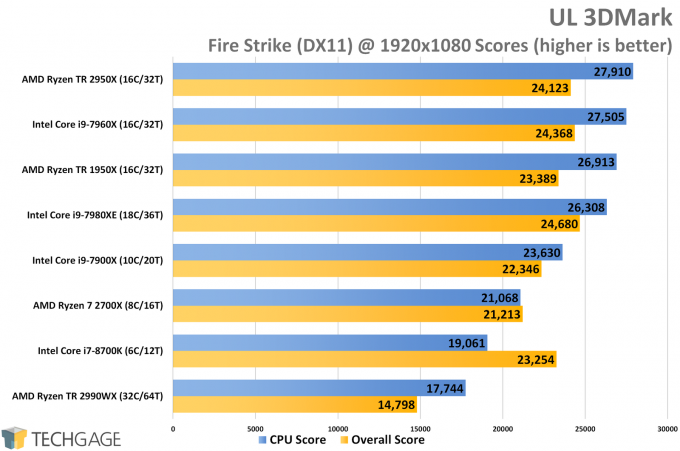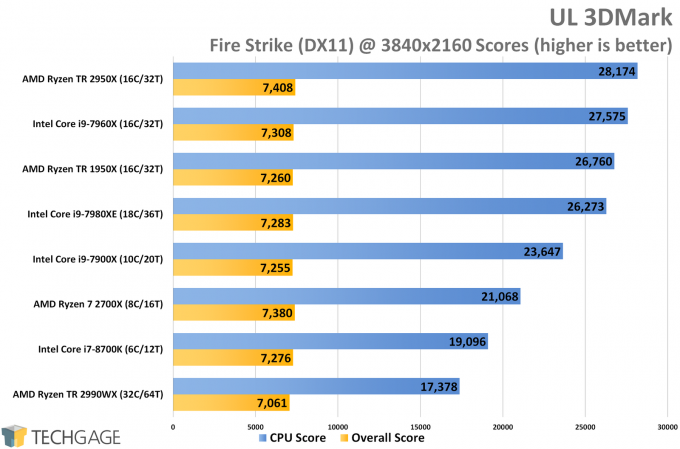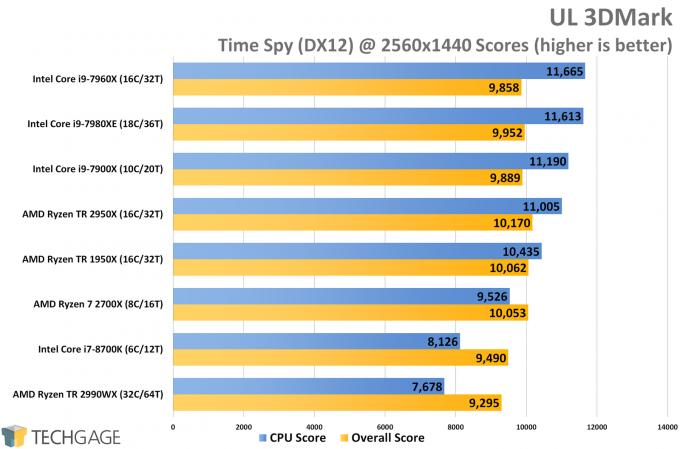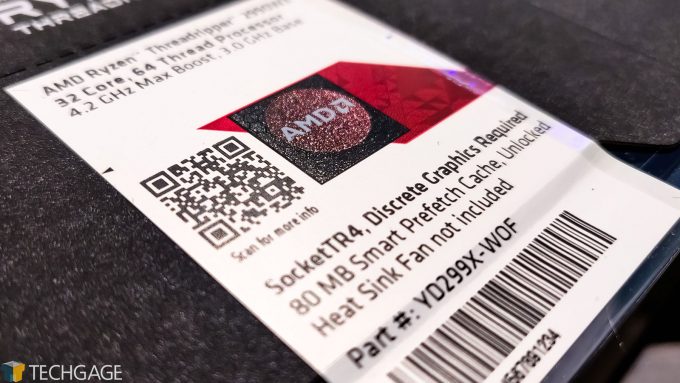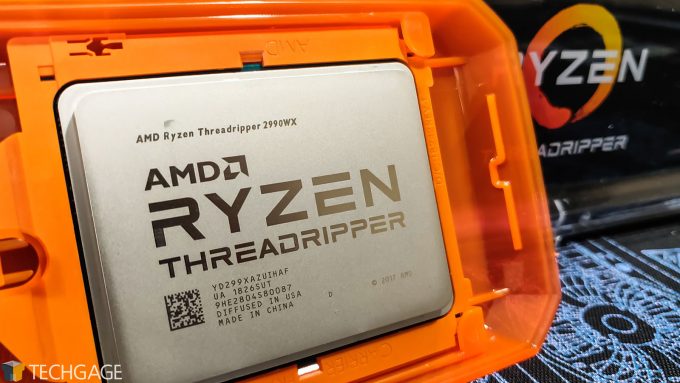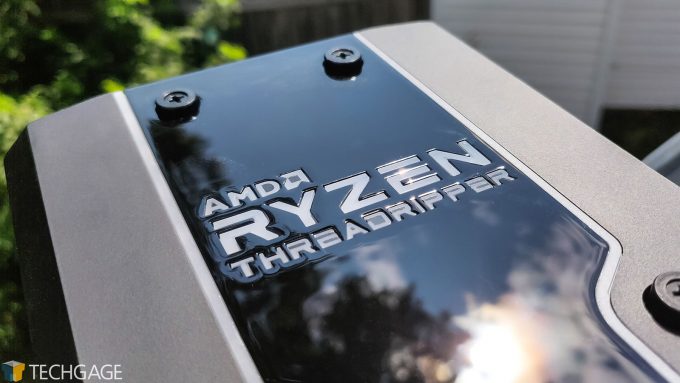- Qualcomm Launches Snapdragon 4 Gen 2 Mobile Platform
- AMD Launches Ryzen PRO 7000 Series Mobile & Desktop Platform
- Intel Launches Sleek Single-Slot Arc Pro A60 Workstation Graphics Card
- NVIDIA Announces Latest Ada Lovelace Additions: GeForce RTX 4060 Ti & RTX 4060
- Maxon Redshift With AMD Radeon GPU Rendering Support Now Available
Workstation Powerhouses: AMD Ryzen Threadripper 16-core 2950X & 32-core 2990WX Review

Just as we were starting to believe that 16-core CPUs were amazing, AMD has come along and dropped a 32-core bombshell. It’s called Ryzen Threadripper 2990WX, a workstation chip that cuts through renderers like butter. We’re putting it up against the forthcoming 2950X, and six other unsuspecting processors.
Page 8 – Gaming & Final Thoughts
With its WX branding, AMD has made it clear that the top-end Threadrippers are not your ordinary CPUs. They’re definitely not meant for gaming, or, at least, that’s not their focus. If you want ultimate gaming, you want high IPC and clock speeds more than lots of cores, so the i7-8700K or 2700X should be considerations.
The unfortunate caveat with many-core chips is that the more cores you add, the lower your overall clocks are going to be. That means that slower multi-core chips will likewise be slower in general usage tasks (not to say you’d notice all of the impact; much of this would require benchmarks to appreciate the differences), whereas high clock chips, like the i7-8700K, will give you the snappiest performance possible.
I will say it’s with a bit of surprise, then, that the 2950X has performed so well in 3DMark, using its effective performance to help drag up its overall score to again lead the pack:
Can you see why the 2990WX isn’t targeting gamers? At 1080p, the detriment is very noticeable, but given just how far behind the top chip’s CPU scores are behind everything else, this again seems like a case of the application not taking advantage of the hardware on offer, a problem I’m hoping will start to disappear more as time goes on, and developers begin to consider these architectures in their code. The problem exists on the gaming side just as well as the software side.
Final Thoughts
It’s not going to be difficult summing this one up. Without question, AMD is offering an unbelievable chip with the Ryzen Threadripper 2990WX. I’m still surprised that it even exists, more than most, it seems. I just couldn’t see AMD literally doubling the core count after a single year, but here we are.
I’ve talked lots about core counts, but in actuality, it’s not the core counts that really matter at the end of the day. Do you buy your Radeons and GeForces based on their core counts? Probably not. What you want is the overall performance. The same principle should be applied here. On one hand, it’s unfortunate that AMD needs 32 cores to only just beat Intel’s 18-core in select tests, but AMD’s charging about the same ($1799) for its 2990WX that Intel is still charging for its 7980XE ($1850).
But it’s not those select tests that are going to matter to most people who are reading this review to learn how the chip can impact their workload. Like any workstation scenario, not everyone’s needs are the same. One chip might excel in one area, but if it’s not the area you deal with, then the point is moot.
If you use Arnold, for example, you stand to see incredible gains in performance with a chip like the 2990WX. The same could be said for pretty much every other renderer tested. Encoding scenarios are really hit or miss, even within the same suite. AMD performed great in certain tests, but fell behind in others – often attributed to applications that wouldn’t use the CPU properly.
Having tested the 16-core and 18-core chips before this, I felt like I was really quite prepared for this performance look. Admittedly, though, I was thrown some curve-balls, but it’s really to be expected. You can’t just double the cores and expect every bit of software to pretend like it doesn’t notice. HandBrake in Linux used literally half of the CPU, for example. Then there were applications like PhotoScan which did not use AMD’s many-core chips too well – or Intel for that matter, since SMT off proved better for both of them.
Fortunately, scaling worked well overall, just to different levels. If you are a render addict, it’s almost guaranteed that you’re going to see enormous gains, and I’d suspect those gains will only get better as time goes on, as developers design for these architectures and core counts. I have suspicions that AMD will be demoing Threadripper with a partner at next week’s SIGGRAPH, which will be a testament to that.
Even with some 35 graphs, it’s hard to wrap this up and feel like I covered enough ground. There’s much more that could have been tackled, but that’s probably best left for follow-up content. Gaming will never be a focus of mine with these biggest Threadrippers, but I will definitely be following-up on testing once in a while to see how the ecosystem has improved to better cater to these big chips. I’ve been in contact with a few ISVs already, and hope to talk to more at SIGGRAPH next week to gauge their thoughts.
If there’s anything I didn’t cover that you think I should have, please feel free to jump into the comment section and let me know. If you also have ideas for follow-up testing, that’d be welcomed, as well. New GPUs are coming soon, so time is strapped, but I am eager to get more testing done with the 2990WX soon. Having all that power on tap is kind of addicting.
I don’t really think about awarding Editor’s Choices that often; it really has to impress me to earn it. And the Ryzen Threadripper 2990WX definitely does earn it. It’s rough around some edges, partly due to AMD’s obsession with releasing more cores before developers realize they need to code for them, but it’s an incredible performer; a true “ultimate” workstation processor. It might not be for your workload, but if it is, the gains will be simply sublime. And, you don’t need exotic cooling for it.
If it hasn’t been stated enough already though, software optimization is required here, especially with SMT involved. While some software may have been exposed to multi-socket systems with very high-end servers and core-counts, for workstations it’s a different matter. The tell-tale signs are good this early in the release based on synthetic tests, but there is considerable room for improvement in some live software.
I know I didn’t touch on the 2950X as much as I should have, but I feel like we honestly knew what to expect from that to begin with, especially given the second-gen Ryzen series, and also what we knew from the 1950X (which was performance tackled just a few weeks ago). Fortunately, the 2950X was in fact faster than the 1950X in every test, sometimes by a greater margin than I expected. A nice iteration, but of course not a reason to jump up from the 1950X. For those looking to build a new rig, and are tempted by a 16-core processor priced at $899, it’s an excellent option.

AMD Ryzen Threadripper 2990WX
Support our efforts! With ad revenue at an all-time low for written websites, we're relying more than ever on reader support to help us continue putting so much effort into this type of content. You can support us by becoming a Patron, or by using our Amazon shopping affiliate links listed through our articles. Thanks for your support!




